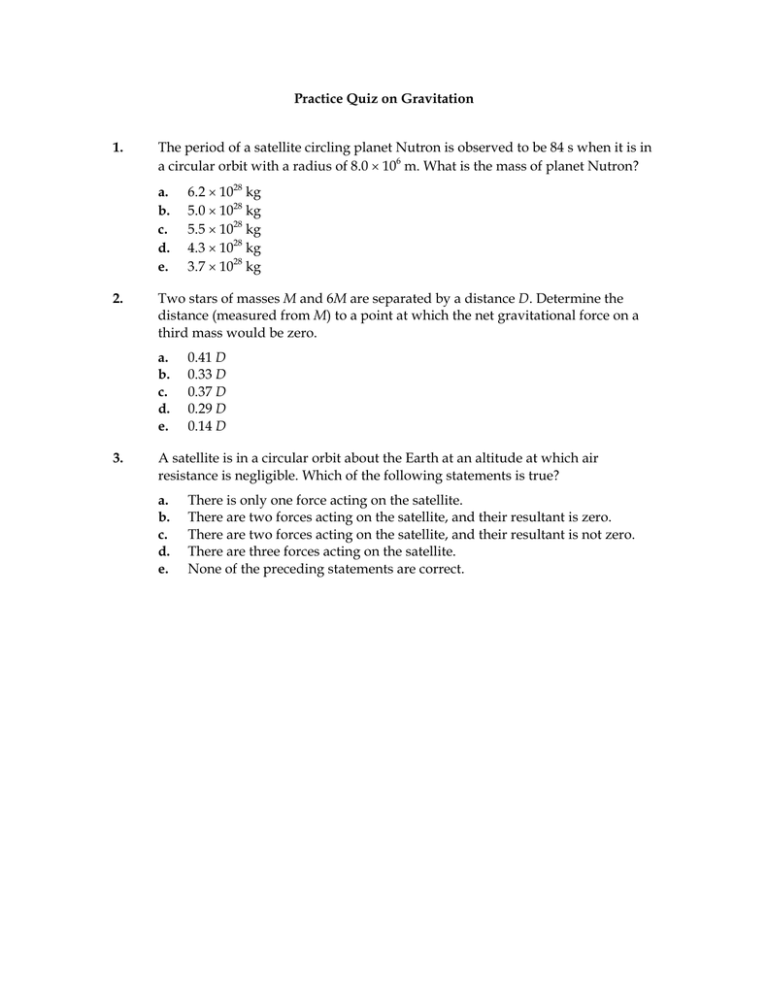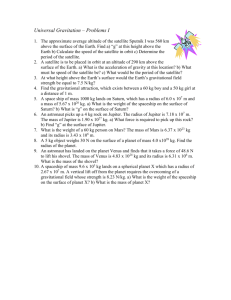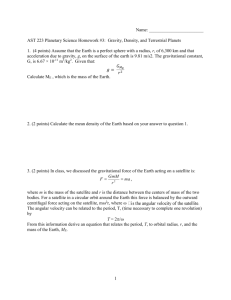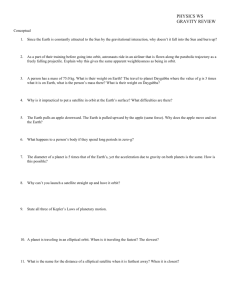Practice Quiz on Gravitation 1.
advertisement

Practice Quiz on Gravitation 1. The period of a satellite circling planet Nutron is observed to be 84 s when it is in a circular orbit with a radius of 8.0 × 106 m. What is the mass of planet Nutron? a. b. c. d. e. 2. Two stars of masses M and 6M are separated by a distance D. Determine the distance (measured from M) to a point at which the net gravitational force on a third mass would be zero. a. b. c. d. e. 3. 6.2 × 1028 kg 5.0 × 1028 kg 5.5 × 1028 kg 4.3 × 1028 kg 3.7 × 1028 kg 0.41 D 0.33 D 0.37 D 0.29 D 0.14 D A satellite is in a circular orbit about the Earth at an altitude at which air resistance is negligible. Which of the following statements is true? a. b. c. d. e. There is only one force acting on the satellite. There are two forces acting on the satellite, and their resultant is zero. There are two forces acting on the satellite, and their resultant is not zero. There are three forces acting on the satellite. None of the preceding statements are correct. 4. Three 5.0-kg masses are located at points in the xy plane, as shown. What is the magnitude of the resultant force (caused by the other two masses) on the mass at x = 0.40 m, y = 0? y 30 cm x 40 cm a. b. c. d. e. 5. What is the gravitational force on a 20-kg satellite circling the Earth (radius = 6.4 × 106 m, mass = 6.0 × 1024 kg) with a period of 5.0 h? a. b. c. d. e. 6. 2.2 × 10–8 N 1.9 × 10–8 N 1.4 × 10–8 N 1.6 × 10–8 N 2.5 × 10–8 N 88 N 55 N 36 N 98 N 18 N A spacecraft (mass = m) orbits a planet (mass = M) in a circular orbit (radius = R). What is the minimum energy required to send this spacecraft to a distant point in space where the gravitational force on the spacecraft by the planet is negligible? a. b. c. d. e. GmM/(4R) GmM/R GmM/(2R) GmM/(3R) 2GmM/(5R) 7. 8. An object is released from rest at a distance h above the surface of a planet (mass = M, radius = R < h). With what speed will the object strike the surface of the planet? Disregard any dissipative effects of the atmosphere of the planet. a. b. ⎡ 2GM ⎤ ⎢⎣ R ⎥⎦ c. ⎡ 2GM (h − R )⎤ ⎢⎣ ⎥⎦ Rh 12 d. ⎡ 2GM ⎤ ⎢⎣ R + h ⎥⎦ ⎡ 2GM ⎤ ⎢⎣ R + h ⎥⎦ 12 e. 12 7.8 km/s 3.5 km/s 5.4 km/s 6.9 km/s 4.8 km/s Planet Roton has a mass of 4.0 × 1023 kg and a radius of 2.0 × 106 m. With what speed should a space probe be launched from the surface of Roton so as to achieve a maximum distance of 3.0 × 106 m from the center of Roton? a. b. c. d. e. 10. 12 An object is released from rest when it is a height h above the surface of a planet of mass M and radius R. What is the speed of the object just before striking the surface of the planet? Neglect any air resistance. Let h = 4.0 × 106 m, R = 5.0 × 106 m, and M = 4.0 × 1024 kg. a. b. c. d. e. 9. 12 ⎡ 2GMh ⎤ ⎢ ⎥ ⎣ R (R + h)⎦ 4.2 km/s 3.9 km/s 3.0 km/s 3.4 km/s 6.0 km/s What is the escape speed from a planet of mass M and radius R if M = 3.2 × 1023 kg and R = 2.4 × 106 m? a. b. c. d. e. 5.5 km/s 4.2 km/s 5.2 km/s 4.8 km/s 3.7 km/s 11. Planet Zero has a mass of 4.0 × 1023 kg and a radius of 2.0 × 106 m. A 10-kg space probe is launched vertically from the surface of Zero with an initial kinetic energy of 8.0 × 107 J. What maximum distance from the center of Zero is achieved by the probe? a. b. c. d. e. 12. A satellite is placed in a geosynchronous orbit. In this equatorial orbit with a period of 24 hours, the satellite hovers over one point on the equator. Which statement is true for a satellite in such an orbit? a. b. c. d. e. 13. There is no gravitational force on the satellite. There is no acceleration toward the center of the Earth. The satellite is in a state of free fall toward the Earth. There is a tangential force that helps the satellite keep up with the rotation of the Earth. The force toward the center of the Earth is balanced by a force away from the center of the Earth. Which of the following quantities is conserved for a planet orbiting a star in a circular orbit? Only the planet itself is to be taken as the system; the star is not included. a. b. c. d. e. 14. 3.2 × 106 m 4.0 × 106 m 6.0 × 106 m 5.0 × 106 m 2.5 × 106 m Momentum and energy. Energy and angular momentum. Momentum and angular momentum. Momentum, angular momentum and energy. None of the above. The figure below shows a planet traveling in a clockwise direction on an elliptical path around a star located at one focus of the ellipse. When the planet is at point A, A STAR a. b. c. d. e. its speed is constant. its speed is increasing. its speed is decreasing. its speed is a maximum. its speed is a minimum. 15. The figure below shows a planet traveling in a counterclockwise direction on an elliptical path around a star located at one focus of the ellipse. When the planet is at point A, STAR A a. b. c. d. e. 16. its speed is constant. its speed is increasing. its speed is decreasing. its speed is a maximum. its speed is a minimum. The figure below shows a planet traveling in a counterclockwise direction on an elliptical path around a star located at one focus of the ellipse. When the planet is at point A, A STAR a. b. c. d. e. 17. its speed is decreasing. its angular momentum is increasing. the gravitational force does no work on the planet.. all of the above are correct. none of the above is correct. Three galaxies, each of mass M = 4.0 ×10 41 kg , lie in a plane at the corners of an equilateral triangle with sides of 5.0 ×10 22 m length. The magnitude of the force the other two galaxies exert on each galaxy is a. b. c. d. e. 4.3 ×10 27 N . 6.4 ×10 27 N . 7.4 ×10 27 N . 8.6 ×10 27 N . 4.3 ×10 28 N . 18. When two solid spheres of the same material and same radius r are in contact, the magnitude of the gravitational force each exerts on the other is directly proportional to a. b. c. d. e. 19. r. r2. r3. r4. r6. Suppose the gravitational force of the Earth on a body was F = − KM E m . What r3 escape velocity v e would a body need to escape the gravitational field of the Earth? 20. a. ve = KM E . 2RE2 b. ve = KM E . RE2 c. ve = KM E . 2RE d. ve = KM E . RE e. v e = KM E . Carla and Jenny are arguing about whether or not it is possible to escape the gravitational field of the Earth. Carla shows Jenny the system below where mass m is rE (not the Earth’s radius) distant from Earth and rP (not planet P’s radius) distant from planet P. Carla states that the mass m has escaped if FP on m = −FE on M . Which one, if either, is correct, and why? a. b. c. d. e. Carla, because the total gravitational force on m is zero at that point. Carla, because there is no gravitational force from Earth on m at that point. Carla, because there is no gravitational force on m from Earth when r > rE . Jenny, because there is a gravitational force on m from Earth no matter how great the distance from the Earth. Jenny, because the gravitational force from the Earth can only be blocked by a body that is larger than the Earth. 1. d 2. d 3. a 4. d 5. c 6. c 7. a 8. d 9. c 10. b 11. d 12. c 13. b 14. c 15. c 16. e 17. c 18. d 19. b 20. d








